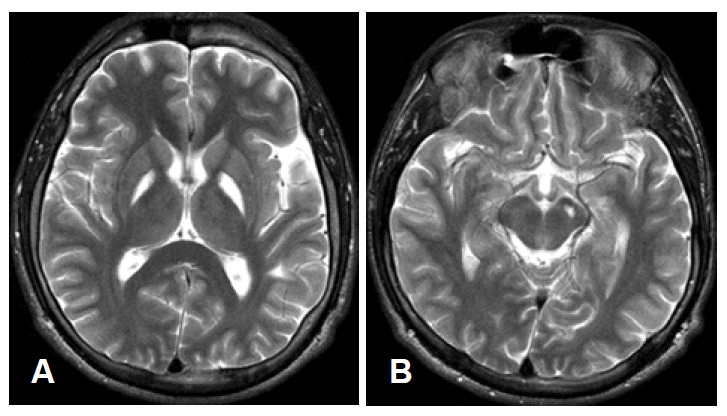Articles
- Page Path
- HOME > J Mov Disord > Volume 2(1); 2009 > Article
-
Case Report
Oculogyric Crisis Associated with Disulfiram-Induced Pallidonigral Lesion - Jae Hyeok Leea, Chul Hyoung Lyoob, Jin Goo Leec, Myung Sik Leeb
-
Journal of Movement Disorders 2009;2(1):48-49.
DOI: https://doi.org/10.14802/jmd.09013
Published online: April 30, 2009
aDepartment of Neurology, Pusan National University Yangsan Hospital, Yangsan, Korea
bDepartment of Neurology, Gangnam Severance Hospital, Yonsei University College of Medicine, Seoul, Korea
cDepartment of Neurology, Incheon Choongang General Hospital, Incheon, Korea
- Corresponding author: Myung Sik Lee, MD, PhD, Department of Neurology, Gangnam Severance Hospital, Yonsei University College of Medicine, 612 Eonju-ro, Gangnam-gu, Seoul 135-720, Korea, Tel +82-2-2019-3322, Fax +82-2-3462-5904, E-mail mslee@yuhs.ac.
• Received: March 16, 2009 • Revised: April 3, 2009 • Accepted: March 25, 2009
Copyright © 2009 The Korean Movement Disorder Society
This is an Open Access article distributed under the terms of the Creative Commons Attribution Non-Commercial License (http://creativecommons.org/licenses/by-nc/3.0/) which permits unrestricted non-commercial use, distribution, and reproduction in any medium, provided the original work is properly cited.
- 9,431 Views
- 66 Download
- 2 Crossref
ABSTRACT
- We report a man who developed oculogyric crisis one month after disulfiram intoxication. Brain MRI showed lesions involving bilateral globus pallidus and left substantia nigra. In our patient, neuronal discharges from pathologically reorganized basal ganglia circuit to the mid-brain ocular motor center might lead to tonic deviation of the eyes.
- A 15-year old boy attempted suicide by taking a high dose of disulfiram (20 mg). Upon arrival at the hospital, he was alert and vital signs were stable. He had not been treated neuroleptics. One month after, he suddenly developed an acute insult consisted of anxiety attack and subsequent retrocollis and forceful upward deviation of the eyes. During the attack, he could not close his eyes and speak, making only grunting noises. He could not move his eyes voluntarily at all, but horizontal oculocephalic reflexes could be elicited. The attack was occasionally accompanied by dystonic posturing of all four limbs. The frequency, duration and intensity of the attacks increased gradually over a period of eight years, occurring more than 10 times a day and lasted up to 2 hours. Neurological examinations between the attacks revealed mild rigidity of the right arm and leg. There was a delay in initiation of saccadic eye movements. He had no motor weakness or sensory deficits, but he needed a help to walk due to foot dystonia. Deep tendon reflexes were normoactive and symmetric. Plantar reflexes were flexor bilaterally. Routine laboratory tests were all normal. Ictal electroencephalography studies were unremarkable. T2-weighted brain MRI studies showed high signal intensity lesions at the bilateral globus pallidus and left substantia nigra (Figure 1). Levodopa treatment was not effective, but the frequency of the attacks decreased markedly after trihexyphenidyl hydrochloride (2.5 mg tid) treatment. Also, the foot dystonia improved partially and the patient could walk a short distance without assistance.
Case Report
- Disulfiram is metabolized to cyanide disulfide (CS2) and produce lesions at the globus pallidus and substantia nigra pars reticulata in monkeys.7 In huans, pallidal or lenticular lesions after disulfiram intoxication have been reported.6,7 However, to our knowledge, lesion at the substantia nigra after disulfiram intoxication is rarely documented on brain MRI studies.
- OGC occurs frequently in association with neuroleptic treatment, postencephalitic parkinsonism, and focal brain lesions at the putamen or globus pallidus.1,2,4,5 These findings suggest that OGC can be caused by basal ganglia dysfunction, particularly of the dopaminergic system. In our patient, neuronal discharges from pathologically reorganized basal ganglia circuit to the midbrain ocular motor center might lead to tonic deviation of the eyes.
- We reported a patient who developed disulfiram induced parkinsonism, dystonia, and OGC, responding markedly to the anticholinergics treatment.
Discussion
Figure. 1.T2-weighted brain MRI shows increased signal intensity in both globus pallidus (A) and left midbrain adjacent substantia nigra (B).


- 1. Onuaguluchi G. Crises in post-encephalitic parkinsonism. Brain 1961;84:395–414.ArticlePubMed
- 2. Leigh RJ, Foley JM, Remler BF, Civil RH. Oculogyric crisis: a syndrome of thought disorder and ocular deviation. Ann Neurol 1987;22:13–17.ArticlePubMed
- 3. Lee MS, Kim YD, Lyoo CH. Oculogyric crisis as an initial manifestation of Wilson’s disease. Neurology 1999;52:1714–1715.ArticlePubMed
- 4. Kim JS, Kim HK, Im JH, Lee MC. Oculogyric crisis and abnormal magnetic resonance imaging signals in bilateral lentiform nuclei. Mov Disord 1996;11:756–758.ArticlePubMed
- 5. Schoser BG, Groden C. Subacute onset of oculogyric crises and generalized dystonia following intranasal administration of heroin. Addiction 1999;94:431–414.ArticlePubMed
- 6. Krauss JK, Mohadjer M, Wakhloo AK, Mundinger F. Dystonia and akinesia due to pallidoputaminal lesions after disulfiram intoxication. Mov Disord 1991;6:166–170.ArticlePubMed
- 7. Laplane D, Attal N, Sauron B, de Billy A, Dubois B. Lesions of basal ganglia due to disulfiram neurotoxicity. J Neurol Neurosurg Psychiatry 1992;55:925–929.ArticlePubMedPMC
REFERENCES
Figure & Data
References
Citations
Citations to this article as recorded by 

- Oculogyric Crisis in a Wilson's Disease Patient
Ping Jin, Xiao‐Ming Fu, Yu Wang, Xin‐Feng Ma, Wen‐Long Ai, Ya‐Yun Xu, Bo Li, Qun‐Rong Ye, Gong‐Qiang Wang
Movement Disorders Clinical Practice.2024; 11(3): 315. CrossRef - Delayed onset of impaired consciousness complicated with ketoacidosis after disulfiram overdose
Kohei Kakimoto, Mayu Hikone, Kazuhiro Sugiyama
Acute Medicine & Surgery.2023;[Epub] CrossRef
Comments on this article
 KMDS
KMDS
 E-submission
E-submission
 PubReader
PubReader ePub Link
ePub Link Cite
Cite

